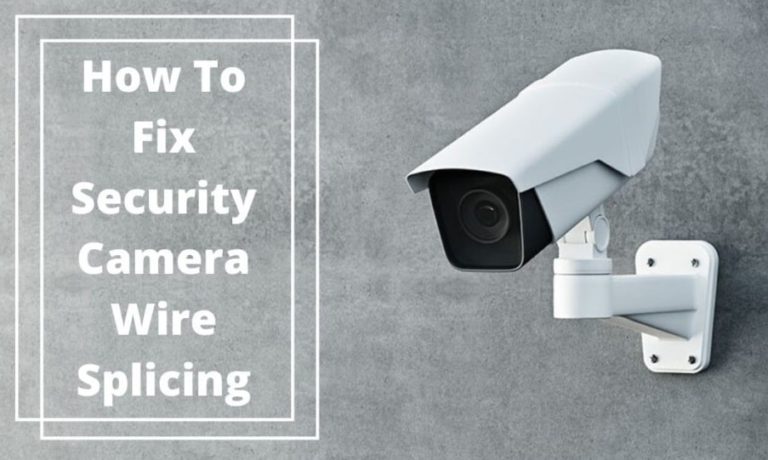Security camera wire splicing is a headache for most camera owners, If you have a security camera inside your home you may face this problem.
The next following words will contain the problems of wire splicing, and a simple guide on how to splice Coaxial, and Ethernet cables.
A Primer For Security Camera Main Cables
In the beginning, when security cameras were invented there was only one type which was Analog security cameras. These analog CCTV cameras use coaxial cables that are thick and can be cut easily.
Years later, a new type of camera has been used to eliminate the problems of Analog security cameras. The new type is Network security cameras.
The network cameras have two types: Wired and Wireless Cameras. The wired security cameras use network cables like Cat5 and Cat6 (Poe cabling) if they are indoor or outdoor cameras.
In addition, this type has fewer problems as compared to Analog cameras. Simply it’s passed from router to cam and vice versa. But the splicing problems still exist in the wired cams as more people setup home security camera in the wrong way.
What are the Main Reasons for Splicing Camera Wires?
There are many reasons for the wire splicing of security cameras, and to make your security system work continuously with great efficiency you need to fix these problems immediately.
As we know, if there are many splices in the security camera wires it will affect the quality of recorded videos. Plus, the data transfer inside the wire will be slow and unstable.
Problems like:
- If you have a short-length wire and you want to extend the wire.
- Moving CCTV camera location will make more splices in wire, Also, when moving DVR.
- Increasing the number of security cams used in the house can make more splices.
- Installing the camera inside the house at a low level makes children cut the wire.
- Bad weather conditions such as rain, dust, and heavy wind can cut and damage the camera wires, and you must repair them.
More and more problems can be avoided if you install camera wiring correctly or you have wireless security cameras, as we know wireless cams use WiFi signals to transfer data like IP monitoring devices.
First
Can security camera wire be spliced? Or Can you cut and splice security camera wires?
Simply the answer is YES, the security camera wire can be spliced whatever its power or data cable. The Power cable is spliced by matching the two old wires with the new power wire, each one done separately. While Ethernet cable is spliced by matching each color of the cable and connecting it to the same color in the new cable.
For example, if you have a power cable you will see two wires inside it: Red Wire & Black wire (Red wire for power, Black wire is the ground wire). Bring your splicing tools and connect the red wires to the old and new wires and put electric tape above the splicing, and the same for the black wire.
In the data cables, it’s a bit different as you must have your tools and connection parts for Ethernet or Coaxial cable.
What is the Best Splicing or Couplers?
The main goal of wire splicing is to connect two wires together. You can do this by using the correct tools and connectors, or you can use couplers (also known as connectors).
There are many advantages of using couplers over splicing. Couplers have a protective sheath that protects the wires, and they also make for a clean connection. In addition, there are no sharp ends to cut when removing them from the connector.
On the other hand, Splices should be used if one end of your cable is missing or damaged so that it can be connected to another part of the system without causing any damage.
However, in the event that you need to repair a broken cable then coupling will not work because they don’t protect any wires from each other as splices do.
The only difference between these two methods is that when you use couplers you must find an identical pair in order for them to work.
Now
How to Fix Security Camera Wire By Using a Coupler?
As we mentioned above, fixing security camera wires and extending them by using couplers (sometimes called connectors) has many advantages that any beginner would love to have without involving wiring problems.
First: Ethernet Cable
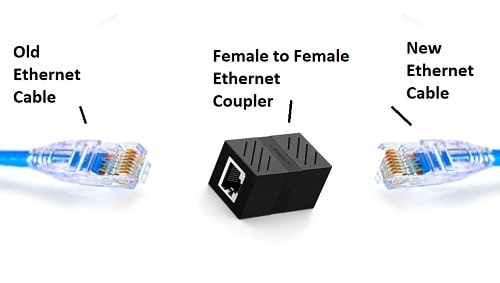
People who have NVR and network IP cameras love to mount their PoE cameras in remote places to allow them to cover every area of their property. But in most cases, they stop from doing this as they don’t know how to extend the Ethernet cables between the NVR, and PoE cam.
Well, if you have been in this case, all you have to do is to get an Ethernet coupler from any trusted seller online. The coupler has two RJ45 female connectors on both sides.
Just bring the old Ethernet cable male, and insert it to the first female of the coupler, then take the male of the new cable and connect it to the second female of the coupler, and finally after connecting the cable from the rj45 coupler, hook it to the wireless, or PoE camera on its new location.
Second: Coaxial Cable
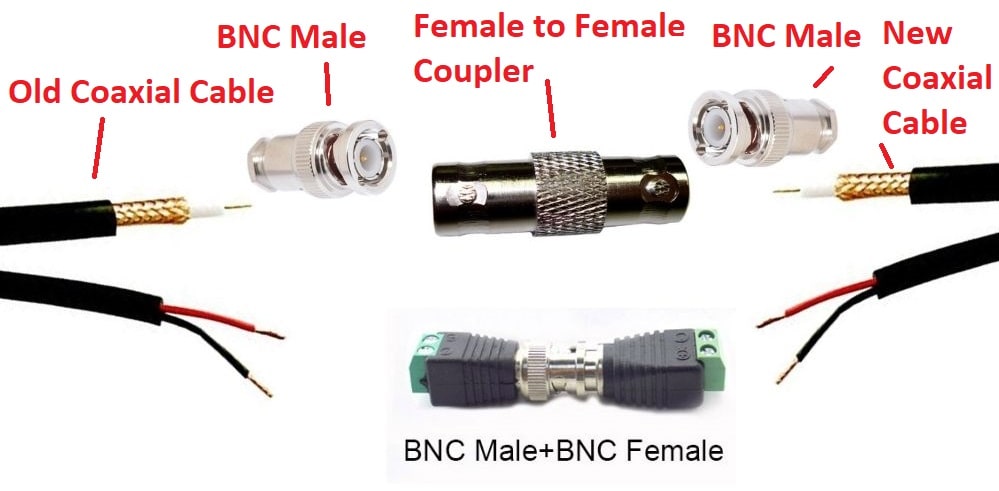
Coaxial cables have a limited distance (500m) and after that, the rate of transmission will be decreased, but what if you have a camera and want to install it beyond this distance? Well in this situation you have to go for Coaxial Cable Coupler.
The coupler of this type of cable differs from an ethernet cable coupler, with a coaxial cable you can choose a male-to-male or female-to-female coupler, the choice of which one you gonna use to extend your cable length depends on your old coaxial cable ends are they male or females.
So, whether you move your DVR or CCTV camera to a new location and fear about the wiring and splicing problems, with this type of couplers you don’t have, your cable will be increased without splicing any part.
How To Splice Security Camera Wires? or How to Repair a Cut Security Camera wire Manually?
Security Camera wire splicing is easy to do manually with no need to hire a professional. You just need to use the right tools and follow the splicing steps mentioned below carefully.
Now.
What are the Tools Used in Security Camera Wire Splicing?
Well, there are many tools you may need to get your job done
- Wire Cutter
- Male and Female for Coaxial cable
- Wire strippers
- Fish Tape
- Electric Tape
- Rj45
- Cable Tester
- Electrical connectors
These are the most used tools for security camera wire splicing. Some additional tools can be used like Drill with bits to make suitable holes to protect wires, a wire junction box can be used to add more protection for your system wires.
How to Splice Coaxial Cable RG59?
As analog cams used in most surveillance systems, Coaxial cable must exist. this analog system cable is called ( Siamese cable or 3-wire), the reason for that is because the cable has one wire for TV-style RG59 to transfer the video signal, and the other two wires for power, positive and negative.
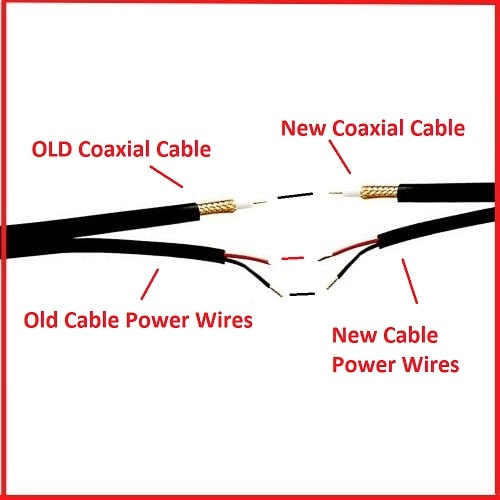
First, make sure that you prepare splicing tools that you will use, like a wrench, pliers, wire cutters, and adhesive tape. and follow the next steps:
Step1:measure the cable length and add a few centimeters as a spare.
Step2:Cut the damaged part of the wires by using Pliers.
Step3:Bring the wire cutter to cut and remove the outside plastic shield.
Step4:Then you will find aluminum and insulated shielding move it away.
Step5:The copper center is surrounded by a white plastic shield to protect the wire from bending, Cut it carefully with the wire cutter.
Step6:Do the same previous steps on the second side of the coaxial cable.
Step7:Match the two copper centers of two wires and make the two wires surrounded by each other.
Step8:Open the electrical tape and cover the splice that we make in the coaxial cable, and check the signal.
Note: You can drill a hole in the wall for wires and hide them to avoid cutting them again.
In the following video, you see how security camera wire splicing is done in Coax RG59.
Source: CCTV Camera Pros
Or you can get more details about the Coaxial cable security camera wire splicing post.
How To Splice 3.1 and 4.1 cable?
There are two types of Coax cable referred to as a 3.1 cable which add 1 more wire to the 3 existing wires to carry audio in 2-way audio cameras, to splice it use the same previous steps mentioned above, and attach each color with the same color in the second cable.
On the other hand, a 4.1 cable is a coax cable used in the analog system also but it has more wires than a regular coaxial cable.
Usually, 4.1 cables are used with Pan-Tilt-Zoom cameras which have a motor to control the camera directions, the additional wires in the 4.1 cable are for the electric motor.
How to Splice Ethernet Cable of a Security camera
Another type of camera wire without a BNC connector is an Ethernet cable. This cable consists of one cable that has 8 wires, each one with a different color from the others.
Whether it’s cat5, cat5e, or cat6 cable all of them have the same steps in fixing spices if they exist.
Note: Some previous steps will be applied in this method also.
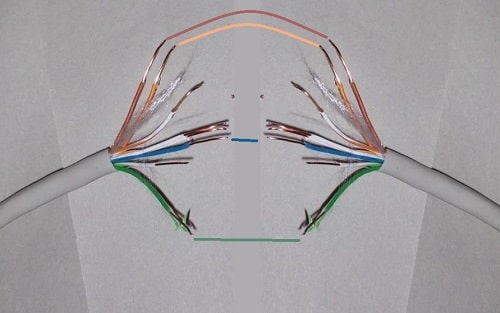
Step1: measure the cable length and leave 1 to 2 inches longer than you need it to be.
Step2: Cut the Ethernet damaged parts by using Pliers.
Step3: Cut the outer insulation of each Ethernet cable. be careful and don’t cut the copper wire.
Step4: Now, you can see the 8 wires of the Ethernet cable( orange-white orange/ blue – white blue/ brown- white brown/green- white green ).
Step5: Unwind the braided pairs and strip the ends of the 8 wires.
Step6: Wind the copper wire of each color with the copper wire of the same color in the second cable.
Step7: Make sure you make each pair of the wire away enough from the other pairs.
Step8: Use the electrical tape to add an insulation layer over the splicing wires.
Note: After finishing splicing Coaxial or Ethernet you can test your work and see the cable work or no?. Just by using Cable Tester.
Important note: if you’re gonna splice your security camera wires, you should have the right tools to avoid damaging the cables of the camera.
You can search and see the Network tool kit that includes all the tools you need.
For more details watch the next video on how to connect to RJ45 on Youtube,
Source: CCTV Camera World
You can also Check-in the details
Ethernet cable security camera wire splicing Post
Power cable security camera wire splicing Post
How do you fix a splice camera wire?
Many people fear doing security camera wire splicing in the wrong way which can cause more problems. And you can avoid splicing in security camera wire just by looking for other methods to fix these problems.
One of the best solutions to solve security camera wire splicing is to use a coupler/extender adapter.
The coupler will make you avoid damaging your security camera wire and ensure that your cable works with good efficiency. Once you search online you can find both the Coaxial cable extender and the Ethernet cable extender.
Another solution is to buy a new security camera wire. In addition, Buying new wires will be cheap and you can take a suitable length for your camera.
Summary
Now, after finishing reading this article you know how to fix security camera wire splicing in both cables. It may take too much time to do if it is your first time to splice a security camera wire.
